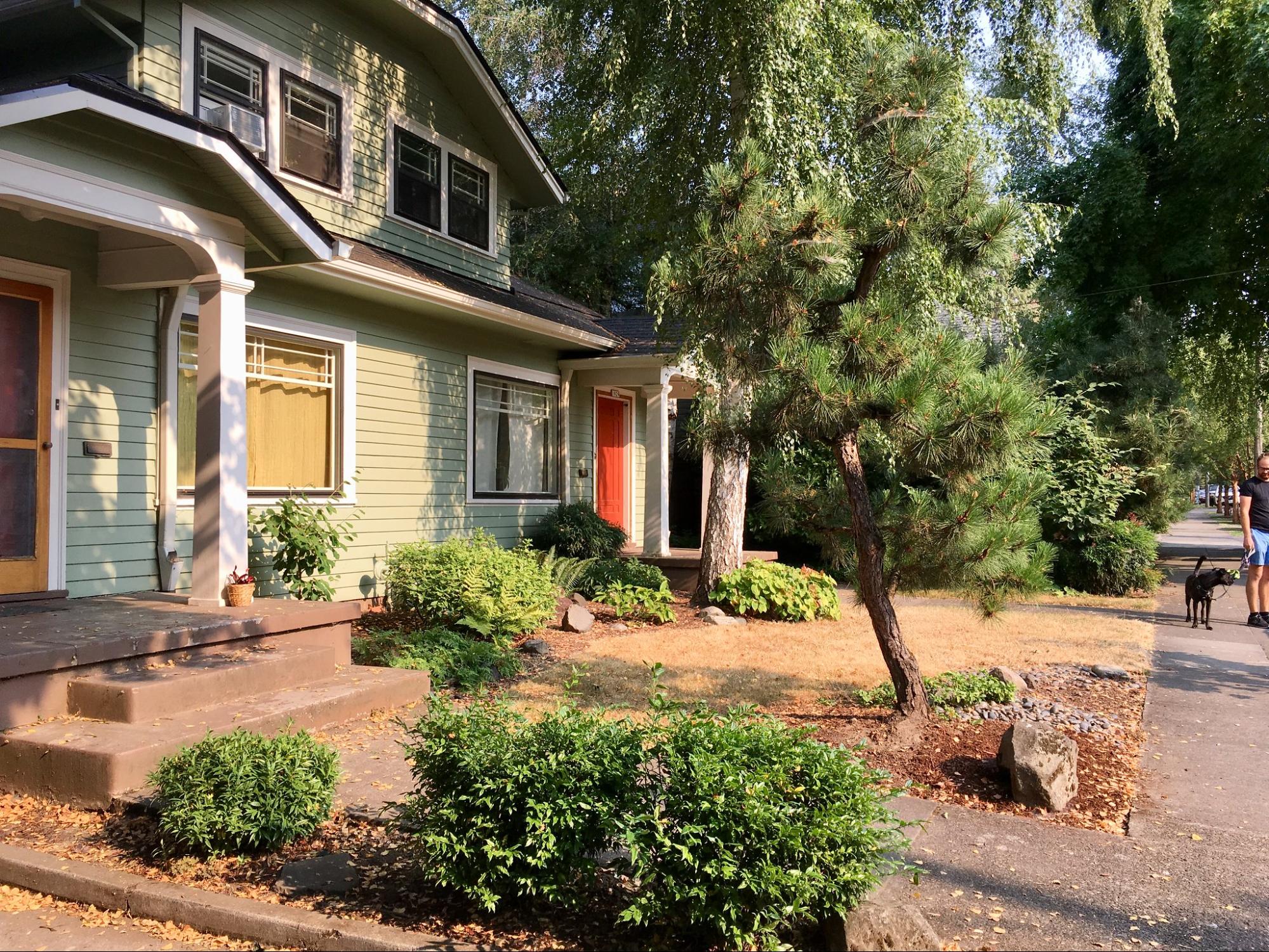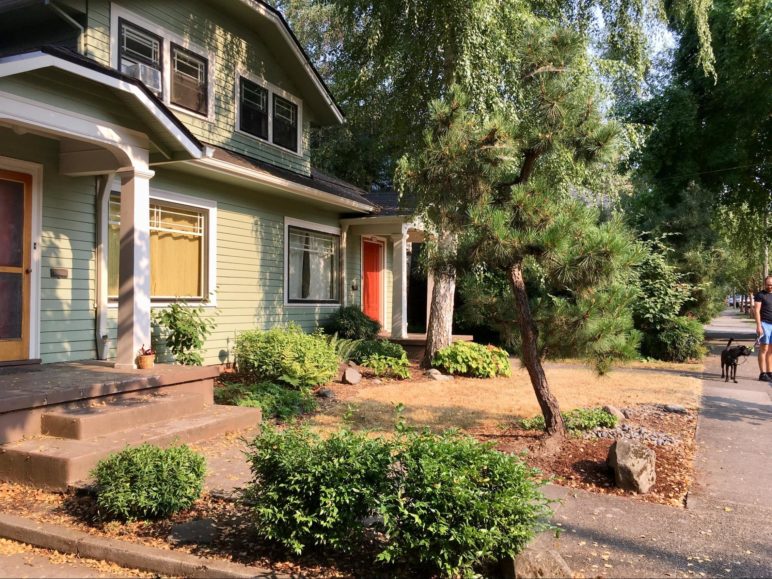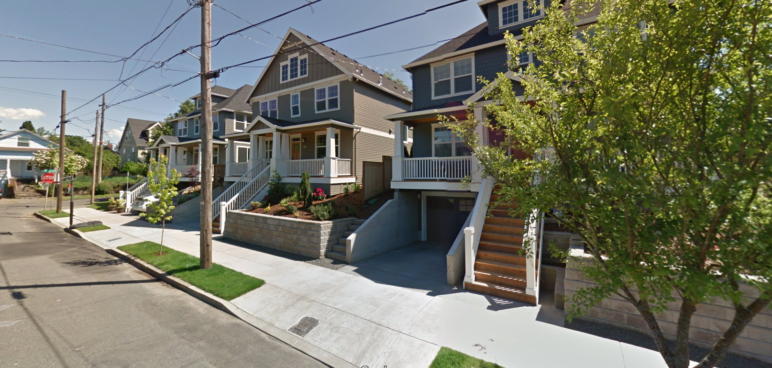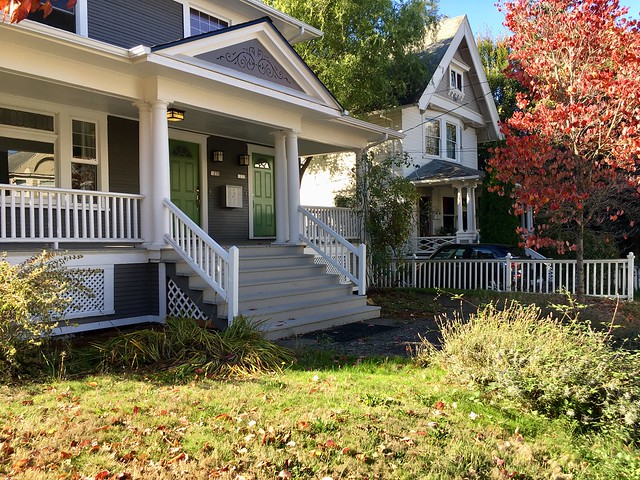To understand why housing policy is climate policy, consider two city blocks with 18 homes each.
On one of those blocks, suppose something happens that’s currently legal almost everywhere: Three relatively old, disintegrating homes are torn down and replaced by three 3,400-square-foot homes.
Let’s call this the McMansion Block.
But on the other block, suppose we do something that’s currently illegal on most of the land in most cities, but would be legalized by reforms like Oregon’s House Bill 2001 or Portland’s residential infill project: we replace the three old homes with a fourplex, a duplex, and a triplex, respectively.
Let’s call this one the Plex Block.
Let’s also suppose that, due to new local caps on total building size, each home in the fourplex is 1,000 square feet; each home in the triplex is 1,150 square feet; and each home in the duplex is 1,500 square feet. (In other words, assume the city has decided to roughly follow Portland’s current proposal and require triplexes to be a bit smaller than fourplexes, etc.) Let’s also assume that each home holds 2.5 people on average, as in the rest of the United States and Canada.
On the McMansion Block, about $2 million has been spent on new construction, but the number of homes on the block hasn’t changed. On the Plex Block, it’s more like $2.1 million on construction, but the block just added six more, smaller homes.
If we compare these two blocks after all the new homes are complete, the housing-related carbon emissions per household of the Plex Block will be about 20 percent lower.

Figures are extrapolated from a 2010 study by the Oregon Department of Environmental Quality.
In this scenario, we haven’t put a price on carbon. The local power company hasn’t shut off its methane plant. Those things should happen as soon as possible, of course—and those things become politically easier when energy consumption per household is lower. But these things haven’t happened yet on Plex Block.
Just one thing is different on Plex Block. Instead of three households living in big homes, nine households are living in smaller ones. The other households don’t change at all. And that, only that, is enough to get Plex Block well on its way to the 90 percent decarbonization it will need to achieve by 2050.
It’s almost as if the Plex Block should be something we’re legally allowed to create. Sadly, on most urban land, we aren’t.
But how are these big carbon savings possible?
The short answer is that keeping a bunch of big, usually-empty rooms warm in the winter and cool in the summer burns a truly massive amount of carbon.
 “No other sector offers a higher potential for a single source of reduction than residential efficiency,” the Natural Resources Defense Coalition concluded in 2017.
“No other sector offers a higher potential for a single source of reduction than residential efficiency,” the Natural Resources Defense Coalition concluded in 2017.
“A typically sized new single-family home built to industry standards is responsible for nearly 60 percent more emissions than a home approximately half its size,” my colleague Margaret Morales wrote last year.
Duplexes, triplexes and quads can also reduce driving—and save everyone money

If you were allowed to live here, you’d be home by now. Photo by Madeline Kovacs, used with permission.
The climate benefits above grow further when we include the potential transportation savings of letting people live closer to each other, to jobs and to shops.
When more people live within walking distance of any given street corner, that corner is more likely to get a frequent bus line, a local shop, a shareable car. Boosting the number of homes on residential blocks by one third (as on the Plex Block) correlates with a drop of about 1,000 miles driven per year per household, Margaret estimated last year—a 5 percent drop even after correcting for household size and income. If we’d assumed these new homes would otherwise have been built on the urban fringe instead of a close-in neighborhood, the contrast would be even sharper.
This density effect is probably strongest if it’s creating new options for living in a transit-rich, walkable area specifically for people who want to live a low-car life but couldn’t previously afford that sort of neighborhood. This, too, is exactly what duplexes, triplexes and fourplexes allow. By letting a few households split the high cost of land, they cut the minimum price for newly built market-rate homes and they boost the number of below-market, subsidized homes per public dollar.
Of course, the same people also save money by living in small, energy-efficient homes and driving less. Enough money, in fact, that many of them are willing and able to cover the transition costs themselves.
“Millions of Americans want to spend billions of their own dollars to cut their carbon emissions in half, if only local zoning would let them,” green housing advocate Payton Chung wrote in January.
Infill housing is no substitute for keeping fossil fuels in the ground, modernizing power grids, switching car trips to transit. We desperately need to do all those things, too. But infill housing makes all those measures go further, and it eases the transition to them.
Small attached homes aren’t right for every household, and they shouldn’t be mandatory. But they should at least be legal for anyone who does want them.
House Bill 2001, which advanced to a Ways and Means subcommittee with four weeks left in Oregon’s legislative session, is poised to set a national example by making Oregon the first US state to re-legalize middle housing in urban areas statewide. With its local “residential infill project” reform, due late this year or next, Portland could become one of the first large cities to enshrine these options in code.
As surely as a windmill or a solar array, every fourplex we build improves the lives of our children and grandchildren. We should all cheer for laws that legalize them—loud enough for everyone to hear.
Note: The rough calculation of home energy efficiency gains here assumes the other detached houses average 1,633 square feet each and have energy efficiency equivalent to a new house. It also assumes all structures will last 70 years; if the structures last longer, then total carbon savings of infill will be even greater. Some of the energy savings estimates here were extrapolated from per-square-foot efficiency gains from a larger attached home compared to a larger detached home. Here’s the spreadsheet I used.













Amy Turnbull
I enjoy reading well-written articles like this that help us understand the benefits of living within a smaller footprint and sharing land more equitabily.
Thank you!
Herb
The problem with your analysis is that we shouldn’t be building any new homes that aren’t net zero. Net zero homes make the carbon savings from the higher density homes compared to the single family home mostly disappear but for the transit benefits of higher density.
Also you don’t discuss where the folks moving into the new smaller units are coming from. If they’ve lived in shared housing -either with parents or roommates before- then the actual space occupied by each person may well increase.
The point is that while there are lots of solid reasons to support higher density housing in single family neighborhoods CO2 reductions are hardly guaranteed. And that real life – and reducing Co2 – is much more complicated – alas -than the simplistic example you give.
Michael Andersen
Herb, I agree that in some cases, household formation leads to more emissions, and that lower housing costs would probably raise the rate of household formation. So one question is: Are we willing to use bans on attached housing to raise everyone’s housing costs in the name of incentivizing people to remain roommates, because roommates are carbon-efficient, even when they would prefer not to be? Also: Is this likely to be a politically viable solution?
For me, the answer to both of these questions is “no.” Especially when a very carbon-efficient course of action that allows more people to live how they like, with lower costs and/or preferred locations, is staring us in the face.
Meanwhile, if we consider a scenario where banning or allowing attached housing has little effect on the rate of household formation, then the tradeoff is between some attached homes in a high-value area some more carbon-intensive detached homes on the exurban fringe. So there’s a clear carbon winner there.
As for net zero, let’s talk again after we’ve mandated universal net-zero construction. Until that happens, let’s find ways to minimize the carbon impact of everything we build.
Ben Paulos
Here in Berkeley we call this “missing middle” housing. See missingmiddlehousing.com.
Katie Jones
As an owner-occupier of a triplex I agree whole heartedly to this piece! At the same time, I have to toot a horn for Minneapolis. Though I know Portland is super hip and progressive, Minneapolis actually is the first city to effectively outlaw single family zoning. The story has been covered twice in the last week in the NYTimes (here’s one story: https://www.nytimes.com/2019/06/15/opinion/sunday/minneapolis-ends-single-family-zoning.html?smid=nytcore-ios-share).
One amendment to this piece is that it is really thanks to two women, Council President Bender and city planner Heather Worthington. We are a weak mayor City and Mayor Frey had little to do with it, though he was supportive.
Michael Andersen
Yep, any progress we’re making here is definitely thanks in part to leaders like Bender, Worthington and other wise folks in Minneapolis. Interestingly, the zoning reform movement in Oregon has also been largely woman-led…
Two quibbles for the sake of the PDX/MSP rivalry, though:
– Oregon’s statewide action would affect *many* more people than Minneapolis’s also awesome and extremely important action.
– Minneapolis has yet to approve the fine print that will be all-important in determining whether anything in Linden Hills actually changes. Portland may well get the code of its local reform on the books first!
Terra Wheeler
It would be great to include the carbon footprint of the new construction. You are probably aware of the Preservation Green Lab Study which concluded for example here in Portland it would take 20 years for a new multi family housing to overcome negative climate change impacts related to the construction process. Also, many of the “disintegrating” houses are made of high quality materials all of which carry embodied energy. I strongly believe that reuse of existing housing is an essential part of carbon reduction. Historic Preservation in its modern form considers existing historic materials and includes energy efficiency, they are not mutually exclusive. Rather than demolishing first I’d like to see how old buildings are actually a valuable asset in the urgency of climate change. Not to mention the fact that existing housing is often the most affordable. There are no protections for residents here in Portland who are on limited budgets and have been historically marginalized. This very real fear of displacement while not directly related to carbon reduction are an important part of the sustainability lens.
Michael Andersen
This analysis does include the carbon footprint of the construction process and the carbon impacts embedded in the new and old materials. Those are the blue and red bars in the charts above.
The carbon costs of construction are meaningful, but they’re dwarfed by the energy consumption of a building’s residence over the life of the building. That’s why, as you say, a new multifamily building (whose material-related carbon impacts are much greater than the low-rise wood-frame situation discussed here) becomes net carbon positive after 20 years. New apartment buildings will definitely last longer than 20 years!
Note that I’m not arguing here in favor of demolition … I’m arguing that every demolition that does happen should result in an energy-efficient outcome.